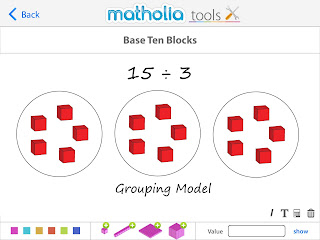When observing a fifth grade teacher the other day, I noticed that while the students were engaged in many positive ways, they relied upon DMSB — Daughter, Mother, Sister, Brother — or some other mnemonic to remember the procedure for long division. They were also ignoring the value of the unit they were dividing. This is very common, but there are better ways, as Singapore Math shows us! Why avoid mnemonics like these to help divide? They lead to place value errors, because all digits are treated the same. They are no easier to remember these than an actual procedure.…
-
-
Find the value of the shapes. Solve for each shape value. This puzzle is appropriate for grade 3 and up. Comment with your solutions or questions! Originally published on the Matholia newsletter. The solution will be coming soon!
-
Many people aren’t aware that there are two different types of division. Even if you search the web, only one type mostly comes up. It’s the type we learn first: that when we share one quantity, we split it into equal parts. This is partitive division, or dividing a quantity into parts. When we divide a whole amount, partitive division tells us how many items there are in each group. Let’s look at a couple of examples. Jeanine bought 24 buns for a party. She wanted to put an equal amount on each of 6 tables.How many buns should she…
-
“There is no right or wrong in mathematics:” a quote from a memoir by the daughter of Fischer Black, a famed US mathematician, that she remembers him saying often. What does that mean? When we learn how numbers work, we can do so in one of several ways. The way many of us have been brought up to learn mathematics is through memorization and learning procedures, such as algorithms. One example is the long division algorithm, which is opaque to most students and is arguably one of the most difficult to learn. Teachers and parents alike can relate to frustration…
-
As of October 2018, I am publishing periodic blog posts and problems on Matholia.com, home of an interactive Singapore Math-based curriculum and web-based tools. Follow the posts here, and subscribe to the Matholia Loop emails, with free problems, here.
-
Based on the need of many older students to improve their multiplication and division fluency, I’ve compiled a set of pattern sheets from the fluency resources available in Eureka Math. These are different from random practice sheets because they are designed for students to recognize patterns and use previous facts to help them solve later facts. More about how this works can be found in the related lessons listed at the bottom of each pattern sheet. Find the pattern sheets to download free here: https://www.teacherspayteachers.com/Product/Multiplication-and-Division-Pattern-Sheets-and-Sprints-4129899
-
Ever since I heard this story, I’ve been working to change my communication with children about what is important. I think this comic says it better than my soapbox speeches. And you can substitute anything else for math, but I chose math because I hear that all the time. *If you’re stuck on helping your child with a concept, try khanacademy.org or other sites like mathplayground.com to refresh your skills and make learning fun for both of you. For more on why this is important, see this Scientific American article titled The Secret to Raising Smart Kids. It has some citations to research showing…
-
If you teach math, or want to enrich your children’s understanding of numbers, here is a set of activities that children will enjoy while learning a lot. You may have heard about Multiple Intelligence Theory. One thing it tells us is that we evolved to have intelligence not only in verbal and mathematical learning, which are the main focuses in our schools, but in a number of different areas. That’s why some of us learn better through music, or nature, or art, or bodily movement. This activity is a kinesthetic (movement-based) way to teach some important number facts. I’ve found…
-
I’m pleased to report that an independent non-profit organization, EdReports.org, is reviewing new Common Core math curricula. I sometimes get asked about my opinion about the different options, but it’s hard to respond when there are so many new materials that I haven’t seen, and I am only one person. While the reviews don’t address every curriculum, they do address many of the available Common Core options. If your district is considering adopting a curriculum, please consider the detailed reports here. They also have a graphic that shows the alignment in a visual format. Click the thumbnail to view it.…
-
Hot off the presses, a new design is available to celebrate Pi Day 2015! Order soon to get yours in time, or order yours later to commemorate the fact you were there. They could also make great prizes for Pi Day celebrations, drawings, or math fairs! Shirts in many colors, mugs, hats, even baby-wear and ties are available. If you would just like a freebie, download my Pi Poster. And for classroom activities, visit this site to get them for $1.99. Happy Epic Pi Day!!

